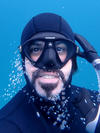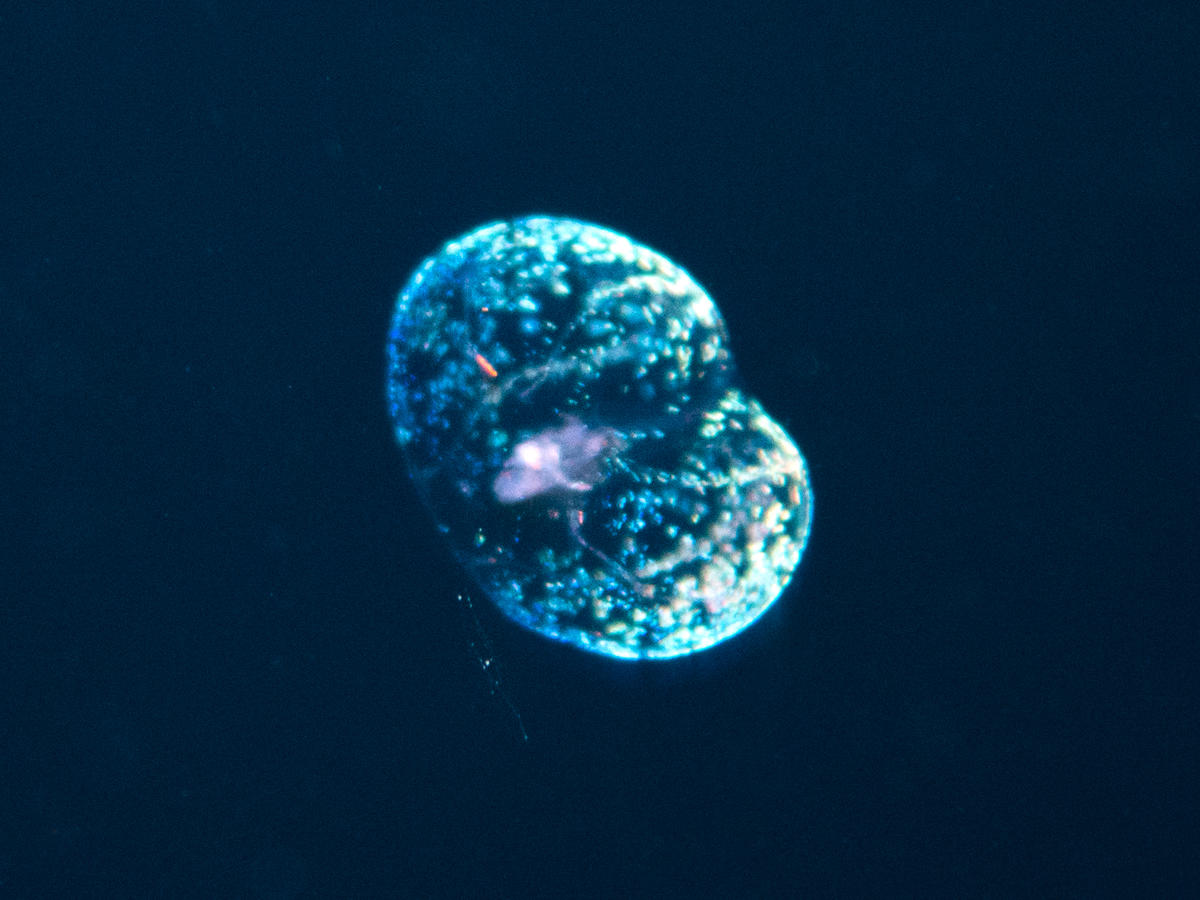
Vasilis STERGIOS le 01/01/22
When I accidentaly stired the water and sent it spinning, this organism started to produce bioluminescense. I let the brightness dimm and repeated with the same results. As you can see, it appears to have a long feeding tentacle with a single row of lures. This was probably retracted when it was disturbed.
Eliot RUIZ le 03/01/22
Great job! I think your right about a siphonophore in the end! The bright orange part seems to correspond well, as well as the lines that I could not explain in the case of a rudimentary house of an appendicularian (which would not cover all the tail by the way).
There are some mentions of bioluminescent patches on the bractea of siphonophores in the literature (see page 5) as well as some pictures.
Vasilis STERGIOS le 03/01/22
A last thought. Should we consider a calycophore, - sphaeronectidae sp.? though I cannot find info on bioluminescense, the following publication (p.20) has a much simmilar image, plus the bright orange part could be a stomatocyst.
Vasilis STERGIOS le 03/01/22
@Eliot RUIZ Thank you so much for all the incredible information - must admit I have read very little on larvaceans and these are very interesting facts! I do believe that both you and @Jacques COVES are right in your hypothesis! The tentacle does not appear to originate from within the organism and as for the flashes of bioluminescense they may be easier to observe in a laboratory in controlled conditions rather than with the naked eye in daylight. All in all, I believe that Oikipleura is the best candidate.
Jacques COVES le 03/01/22
Thank you Eliot for these explanations. In the hypothesis of Oikopleura spp., the orange thing could be any waste trapped in the house which serves obviously as a filter that prevents large pieces from passing.
Eliot RUIZ le 03/01/22
Hi, I also think it looks like an appendicularian in a very small house. It might be constructing it (2-5 renewals per day) which could explain the size of the house and the absence of visible filters. The tentacle might just be a fragment of some siphonophore (they often break) who stuck to the house. And then, you might have removed it when you disturbed the water.
About the bioluminescence, there are some descriptions of bioluminescence in appendicularians which comes from granular inclusions in the house rudiments. In this article, you can see drawings of the bioluminescent pattern (yours seems to correspond to Oikipleura vanhoeffeni). The big size for an appendicularian could also correspond to this species which is about 1cm in length but has only been fished in the North-East Atlantic sea. In this article, you can see a description of a behaviour similar than you describe with mechanical stimulation resulting in the production of a blue-green light by the granular inclusions in the house. Finally, in this recent article, you have some hypotheses about the formation of the bioluminescence: "Light emission occurs as blue flashes of light from its body that can be induced by mechanical stimulation [88]. This animal has also been reported to emit light in the presence of coelenterazine, so it is possible that these are able to acquire coelenterazine from exogenous sources [87]. Larvaceans like O. dioica can secrete their luminescence as a mucus that will capture and collect particulate organic matter whilst the animals are filter feeding [89]. These secretions form luminescent “houses” or clusters of organic matter which can harbour all of the components for the bioluminescent reaction. On mechanical stimulation, these “houses” emit blue light showing that the components luminescence are all present in a way such that coelenterazine does not undergo autooxidation. This display of luminescence supports coelenterazine being utilised by this and other filter feed-ers for semi-intrinsic luminescence as stable luciferins can potentially be found in particulate organic matter that these organisms can feed on [87, 88, 90]."
However, there are still some things that do not match: you don't evoke repeated flashes of bioluminescence and I have no idea about what could be the little orange parts...
Vasilis STERGIOS le 02/01/22
@François LELEU , @Jacques COVES
Organism size is about 1cm in diameter.
As you can see in the second shot, the surface is smooth with no external formation to suggest the presence of cilia, thus removing ctenophores from the puzzle.
Since the bright blue/turquoise patches appeared once I disturbed the organism and remained visible while it was spinning in the water, we can also dismiss a mucous membrane and place aside reflective plates for the time being.
I did a more thorough check in the shots I dismissed as too blurry and found one where there it is clear that there are thin tentacles originating from the underside of what appears to be the forward part of the organism (judging by the shape).
Hope this next shot, though blurry, will give a better understanding of the shape.

François LELEU le 02/01/22
Hi Vasilis,
Maybe Hormiphora plumosa without warranty just to give you a track.
You indicate the presence of bioluminescence. But the description of similary species only mentions iridescence and two feeding tentacles. If the feeding tentacle you seen was retracted for the second picture, a second feeding tentacle could alredy be retracted when you took the first picture, to match the proposed specy.
Jacques COVES le 02/01/22
Do you have an idea of the size of this species.
It looks like Oikopleura spp. but the presence of a feeding tentacle is puzzling in this hypothesis.
Les textes et images sont sous licence et ne sont pas libres de droit.
Pour les ayants-droits, connectez-vous.
Pour toute demande d'utilisation (exemple d'un formateur Bio de la FFESSM...) contactez nous ici.